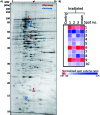Exposure to microwave irradiation at constant culture temperature slows the growth of Escherichia coli DE3 cells, leading to modified proteomic profiles
- PMID: 35517035
- PMCID: PMC9063421
- DOI: 10.1039/c9ra00617f
Exposure to microwave irradiation at constant culture temperature slows the growth of Escherichia coli DE3 cells, leading to modified proteomic profiles
Abstract
Despite a few decades of research, interest continues in understanding the potential influences of low energy microwave irradiation on biological systems. In the present study, growth of E. coli DE3 in LB media slowed in the presence of microwave irradiation (max. 10 W) while the temperature of cultures was maintained at 37 °C. Viable cell counts in microwave-irradiated cultures were also significantly lower. When microwave irradiation was ceased, E. coli growth was restored. A top-down proteomic analysis of total proteins isolated from control and microwave-irradiated E. coli cultures revealed differential abundance of 10 resolved protein spots, with multiple proteins identified in each following mass spectrometric analysis. Among these proteins, a number are involved in metabolism, suggesting alterations to metabolic activities following microwave irradiation. Furthermore, four amino acid-tRNA ligases were also identified, pointing to the possibility of stress responses in E. coli under microwave irradiation.
This journal is © The Royal Society of Chemistry.
Conflict of interest statement
The authors declare no conflict of interest.
Figures






Similar articles
-
[Effect of high frequency treatment on several microorganisms important to food health].Zentralbl Hyg Umweltmed. 1989 Jun;188(3-4):271-83. Zentralbl Hyg Umweltmed. 1989. PMID: 2667555 German.
-
Mathematical model of manganese ion catalyzed microwave deactivation of Enterococcus faecalis, Staphylococcus aureus and Escherichia coli.Cell Mol Biol (Noisy-le-grand). 2007 May 15;53(3):49-54. Cell Mol Biol (Noisy-le-grand). 2007. PMID: 17531149
-
Kinetics of Escherichia coli destruction by microwave irradiation.Appl Environ Microbiol. 1992 Mar;58(3):920-4. doi: 10.1128/aem.58.3.920-924.1992. Appl Environ Microbiol. 1992. PMID: 1575494 Free PMC article.
-
Comparison of chromatographic band profiles obtained under microwave irradiated and non-irradiated reversed-phase liquid chromatography column.J Chromatogr A. 2005 Oct 28;1092(2):222-7. doi: 10.1016/j.chroma.2005.07.028. J Chromatogr A. 2005. PMID: 16199229
-
Extracellular sensing components and extracellular induction component alarmones give early warning against stress in Escherichia coli.Adv Microb Physiol. 2001;44:215-57. doi: 10.1016/s0065-2911(01)44015-x. Adv Microb Physiol. 2001. PMID: 11407114 Review.
Cited by
-
Proteomics-The State of the Field: The Definition and Analysis of Proteomes Should Be Based in Reality, Not Convenience.Proteomes. 2024 Apr 19;12(2):14. doi: 10.3390/proteomes12020014. Proteomes. 2024. PMID: 38651373 Free PMC article.
-
Direct measurement of non-thermal microwave effects on bacterial growth and redox dynamics using a novel high-throughput waveguide applicator.Philos Trans A Math Phys Eng Sci. 2025 May 22;383(2297):20240073. doi: 10.1098/rsta.2024.0073. Epub 2025 May 22. Philos Trans A Math Phys Eng Sci. 2025. PMID: 40400323 Free PMC article.
-
Optimized Proteome Reduction for Integrative Top-Down Proteomics.Proteomes. 2023 Mar 6;11(1):10. doi: 10.3390/proteomes11010010. Proteomes. 2023. PMID: 36976889 Free PMC article.
References
LinkOut - more resources
Full Text Sources

